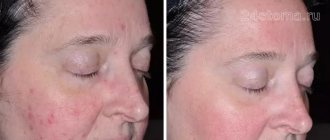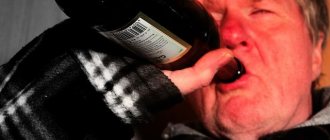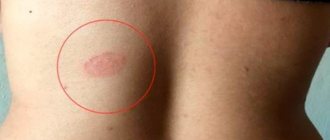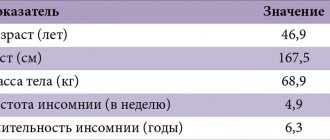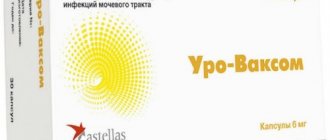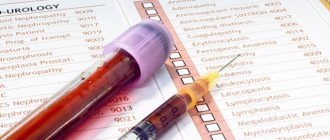Questions, answers, reviews on the drug Solantra
You can look at questions about the drug, as well as ask your question to a specialist, using a free consultation with a pharmacist or pharmacist.
The information provided is intended for medical and pharmaceutical professionals. The most accurate information about the drug is contained in the instructions supplied with the packaging by the manufacturer. No information posted on this or any other page of our website can serve as a substitute for personal contact with a specialist.
| * | Our site does not sell medicines and other goods; they must be purchased in pharmacies, in accordance with current laws. Data on prices and availability in pharmacies is updated twice a day. Current prices can always be seen in the section Searching and ordering medications in pharmacies. |
Solantra®
Suction
The absorption of ivermectin contained in Solantra was assessed in a clinical study involving adult patients with severe papulopustular rosacea using the maximum tolerated dose of the drug. At steady state (after 2 weeks of treatment), the highest mean (± standard deviation) ivermectin plasma concentrations were observed within 10 ± 8 hours after dosing (Cmax: 2.1 ± 1.0 ng/ml, range: 0. 7-4.0 ng/ml), and the highest mean (± standard deviation) AUC0-24 h was 36 ± 16 ng h/ml, range: 14-75 ng h/ml). Systemic exposure to ivermectin reached a plateau by the end of the second week of treatment at steady state. With longer treatment durations in phase 3 studies, systemic exposure to ivermectin remained the same as after two weeks of treatment. At steady state, systemic exposure levels of ivermectin (AUC0-24 h: 36 ± 16 ng h/ml) were lower than after a single oral dose of 6 mg ivermectin in healthy volunteers (AUC0-24 h: 134 ± 66 ng h/ml) .
Distribution
An in vitro study showed that the binding of ivermectin to plasma proteins (mainly albumin) is more than 99%. No significant binding of ivermectin to erythrocytes was observed.
Metabolism
In in vitro studies using human liver microsomes and recombinant CYP450 enzymes, it was noted that ivermectin is metabolized primarily by CYP3 A4 inhibitors.
In vitro studies have shown that ivermectin does not inhibit CYP450 isoenzymes 1A2, 2A6, 2B6, 2C8, 2C9, 2C19, 2D6, 3A4, 4A11 or 2E1. Ivermectin does not induce the expression of CYP450 enzymes (1A2, 2B6, 2C9 or 3A4) in cultured human hepatocytes. 2 main metabolites of ivermectin (3”-O-demethyl ivermectin and 4a-hydroxy ivermectin) were identified during a clinical pharmacokinetic study using the maximum permissible dose of the drug and were studied during phase 2 clinical trials. Like the parent compound, the metabolites reached equilibrium by the end of the second week of treatment, with no signs of accumulation observed up to 12 weeks. In addition, systemic exposures of metabolites (assessed using Cmax and AUC) obtained at steady state were much lower than those after oral administration of ivermectin.
Elimination
The terminal half-life averaged 6 days (approximately 145 hours, range: 92-238 hours) in patients who applied the drug to the skin once daily for 28 days in a clinical pharmacokinetic study at the maximum tolerated dose of the drug. . Removal from the body depends on the degree of absorption after external application of Solantra cream. The pharmacokinetics of ivermectin have not been studied in patients with hepatic or renal impairment.
What should you not do if you have rosacea?
Rosacea and rosacea, although not the same thing, have similar limitations. If you have rosacea, you should avoid the following:
- baths and saunas
- artificial tanning in a solarium
- traumatic facial cleansing
- laser resurfacing
- cosmetics with acids and alcohol
- scrubs and peelings with hard particles
- thermal masks
- contrasting washes
Acne, rosacea and rosacea should be treated by eliminating harmful foods from the diet:
- alcohol and carbonated drinks
- baked goods, sweets and cakes
- all types of red meat
- canned, spicy and salty foods
Diagnostics
The diagnosis, as recommended in medical textbooks and articles, is made based on the results of a physical examination of the visible manifestations of the disease and clarification of the medical history. The patient is asked in detail about the time of onset of primary symptoms. The doctor may ask about factors that, in the patient's opinion, reduce or increase symptoms. An additional research method, biopsy, is rarely used. This is the removal of a small piece of skin with a swab or scraping to identify parasites. In rare cases, monthly blood chemistry tests are performed for total bilirubin, serum alanine aminotransferase, aspartate aminotransferase, triglycerides, total cholesterol, glucose, serum creatinine, or alkaline phosphatase. Sometimes testing is done for antinuclear antibodies, which appear in the bloodstream as indicators of destruction of connective tissue cells. According to indications, seek advice from one of the specialists: an ophthalmologist, gastroenterologist, endocrinologist or psychotherapist.
An ophthalmologist is necessary if there is a risk of developing ocular rosacea. This specialist can prescribe supportive measures to alleviate the patient’s suffering: relieve the feeling of pain and dryness in the eyes, reduce sensitivity to bright light.
The gastroenterologist will prescribe additional diagnostic procedures to assess the condition of the digestive system. He can develop recommendations for proper nutrition or therapeutic fasting. It has been confirmed that smoked foods, saltiness, spices, citrus fruits, coffee-containing drinks, as well as alcohol increase the redness of the facial skin and provoke the appearance of new rashes.
An endocrinologist uses an examination to identify hormonal imbalances. Pathologies of the endocrine system often cause hot flashes. If unpleasant skin rashes appear, pre-prescribed hormonal therapy requires adjustment.
The psychotherapist will conduct a conversation to determine the general psycho-emotional state. He will advise what psychological techniques, relaxation techniques or sedatives can be used to get rid of depression. Patients suffering from rosacea, especially the severe form, often become more shy and withdrawn. Women usually hide imperfections with camouflage cosmetics, hide them behind long hair, and do not like to be seen. Females aged 30 to 40 years are at risk.
What cosmetic procedures can be done for rosacea?
When treating rosacea and rosacea on the face, you cannot do without cosmetic procedures. But not all of them are allowed for vascular pathologies.
The following help to effectively get rid of rosacea and rosacea:
- Phototherapy. Pulsed light affects pathological tissues. The targets of the rays are microorganisms and altered capillaries. Under the influence of photo flashes, old collagen fibers are destroyed and the production of new ones is started. The main feature of phototherapy is the ability to glue blood vessels. The rays heat the vessel to 60 degrees, which provokes blood clotting and the vessels become empty.
- Plasma therapy. The procedure is based on the use of autogenous plasma. Plasma therapy triggers skin cell restoration processes, normalizes metabolism, and saturates the skin with useful substances. In the dermis, collagen synthesis is enhanced and inflammation processes are reduced.
What is rosacea and how to get rid of it?
Cuperosis can be either an independent manifestation of changes in the skin or a sign of serious diseases. Cuperosis occurs in several stages:
- Rapid redness for no obvious reason. After a while, the redness disappears without consequences - the vessels are still elastic to restore their original state.
- A characteristic pattern of blood vessels appears on the skin. This is a sign that the blood vessels cannot return to normal.
- Chronic blood circulation disorders and lack of nutrition of skin cells.
A cosmetologist knows how to treat rosacea and rosacea. You can get rid of skin pathologies in a comprehensive manner by identifying the cause of the disease. If rosacea is caused by a disease of the internal organs, they need to be treated first. The use of only external agents will eliminate the manifestations of rosacea, but will not protect against the appearance of new spider veins. A combination of therapy methods that complement each other will achieve lasting results.
Rosacea. Full Review and Treatment Options
What are spider veins?
This is a manifestation of rosacea and general redness of the skin.
But we need to fight them in different ways. If we can combat general redness of the face with cosmetics that prevent redness of the skin and soothe the skin (irritation). You can use medications that are used for rosacea; they are prescribed by dermatologists and cosmetologists to remove this exacerbation, reduce redness and put it into remission (a calm period of facial skin). Spider veins are a different story than facial redness, although these are still the same manifestations of rosacea. You can’t put cream on them to make them shrink, you can’t “stab” them with a mesopreparation to make them go away. Here it is necessary to use direct physical influence. With laser technologies, it is possible to locally remove (seal) microvessels with a narrowly directed beam of light.
Video about rosacea: You can’t cover up spider veins. How to delete?
A cosmetologist is considering different options for removing spider veins.
Contact a specialist and he will tell you exactly how to remove spider veins. Different clinics have different laser devices, and the disadvantage of a laser is that it can only remove small single vessels, bright stars.
But it’s impossible to remove the stars and all the redness on the face at the same time. Laser technology does not allow this. For this purpose, there is IPL intensive diffused light technology. This technology is called photorejuvenation differently, it has a different mechanism.
photorejuvenation
How does photorejuvenation work on blood vessels?
For rays of intense light, the pigment is the target. For example, during photoepilation it is hair pigment, and during photorejuvenation (when we work with blood vessels) it is blood pigment. How does it work? The intense light heats the hemoglobin in the blood vessel. The vessel is glued together and then replaced by connective tissue. A large area of the face is being treated, and therefore it is possible to treat the entire face and work with individual vessels at the wings of the nose and remove spider veins on the face. For rosacea, I myself prefer to work with IPL. Using this technique and procedures, I can do the maximum for a person who has rosacea, stars and redness.
How often should treatments be done for rosacea and how long is the effect?
procedures for rosacea
We cannot remove spider veins forever. We remember that rosacea is a constitutional feature of the body and we cannot be 100% sure that we have removed it and you will not have it again.
If we take a specific spider vein on your face or along the sides of the nose, then we can work on these areas three to four times in order to remove the vessels. Sometimes one procedure is enough, sometimes three or four procedures are needed with an interval of 3-5 weeks. It is necessary to carry out these procedures in the autumn-winter period, when the sun is active in the sky; it is undesirable to do this.
The effect lasts differently for everyone. In order for it to be maximum, it is necessary to follow all the cosmetologist’s prescriptions, including those regarding lifestyle. Do not use provocative situations with temperature fluctuations and do not consume products that provoke rosacea.
If you use special cosmetics, if you don’t go to the bathhouse or drink red wine, then the effect will last for the maximum period. Perhaps it will be a year, perhaps two years, then you will go through the whole 10 years without spider veins.
If you do not follow the recommendations of your cosmetologist, then be prepared for rosacea to return very quickly. And one more very important point: vascular manifestations at the wings of the nose and on the cheeks here they appear not just because there are some provocateurs. Patients come to me all the time, not even with blood vessels! And right with a red nose, with red cheeks only because they have been squeezing blackheads in this area for years and removing blockages on their own.
Remember, if you are prone to rosacea and have blood vessels, do not cleanse your face daily or weekly. All such traumatic procedures by a cosmetologist should be kept to a minimum.
- Cosmetologist Yuliana Shiyan
Prevention
Along with treatment, preventative measures are also important. To prevent the development of rosacea, you need to avoid exposure to:
- sun and wind;
- unhealthy diet;
- harmful drinks;
- medicines;
- aggressive cosmetic procedures (peelings, surgical skin smoothing, rubbing, warming masks, etc.).
For prevention, specialists regularly prescribe short courses of antibiotics. It is recommended to constantly care for the skin with cosmetic products for gentle cleansing, moisturizing and protection from ultraviolet radiation (for sensitive skin). It is necessary to remember about the treatment of concomitant pathologies, especially diseases of the digestive tract. Getting rid of the consequences does not diminish the cause of the illness.
History and diagnosis
The patient considers herself ill for about three years, when she first noted the appearance of persistent redness of the face in the area of the cheeks and chin.
On the recommendation of a dermatologist, I used Metrogyl gel [1] topically and Trichopolum 250 mg orally for a course of 3 weeks. During the therapy, the patient noted a temporary improvement in the form of a decrease in facial hyperemia, but 2 months after stopping treatment, the process resumed. In addition, in addition to redness of the skin, there was a feeling of tightness, itching and multiple large pustular elements, painful on palpation.
When I returned to the doctor, I was tested for demodex - it was not detected. The dermatologist prescribed topical Celestoderm B cream with garamycin for a 4-week course, which resulted in almost complete regression of all existing rashes.
Subsequently, when the disease relapsed, the patient independently haphazardly used topical corticosteroids for almost two years. Gradually, I began to notice the formation of subcutaneous lumps in places where large pustular elements were previously located, facial hyperemia became brighter, and irregularities and retractions appeared on the surface of the skin of the cheeks. According to the patient, without the use of hormonal creams and ointments, the rashes on the facial skin intensified, but even when returning to their use, a complete clinical cure did not occur.
The patient notes that she is forced to use a large amount of foundation every day to camouflage cosmetic imperfections. At the reception, attention is drawn to the fact that the woman is in a depressed psycho-emotional state, formed due to the low effectiveness of previous therapy, disbelief in the success of further treatment and dissatisfaction with her own appearance. During the consultation, we managed to convince the patient that modern injection correction methods will solve not only dermatological, but also aesthetic problems.
Abstract
A description of a clinical case is presented: a patient with subcutaneous scar changes in the area of the cheeks and chin secondary to steroid rosacea. Correction of cosmetic defects was successfully carried out by introducing into the problem area sequentially and alternately an enzyme preparation based on hyaluronidase subcutaneously and a biorevitalizant with hyaluronic acid and a vitamin-mineral complex intradermally.
Key words: rosacea, Metrogyl, Mirvaso, hyaluronidase, Longidase, polyrevitalization, NCTF-135, combination therapy.
Patient Ch., 38 years old, came to the clinic with complaints of redness and flaking of the skin in the area of the nose, cheeks, forehead and chin, accompanied by a feeling of tightness and dryness; pustular rashes on the skin of the cheeks and chin, painful on palpation; “irregularities” in the relief of the skin of the cheeks.
What should you not eat if you have rosacea?
Rosacea and rosacea on the face are diseases that require a comprehensive approach to treatment. First of all, this concerns nutrition. To get rid of rosacea, you need to exclude dangerous and harmful foods from your diet:
- Sweet and floury. They contain sugars that cause inflammation
- Dairy products. Progesterone, which dairy products are rich in, enhances the functions of the sebaceous glands - there are more purulent inflammations on the skin.
- Alcohol. It has been scientifically proven that alcoholic drinks themselves do not cause rosacea, but aggravate the course of the disease. Alcohol dilates blood vessels and causes an additional blush on the face.
- Products containing caffeine (tea and coffee). They stimulate the production of the hormone cortisol, which triggers stress. Stressful situations often lead to inflammation on the skin.
- Canned, pickled, salted, fried and spicy foods. They lead to acne on the skin, dilate blood vessels, and weaken the immune system.
- Citrus and sweet fruits. Causes skin inflammation.
Can rosacea be treated with laser?
Couperosis and rosacea can be eliminated with laser. Vascular networks are cauterized with laser beams. The method is effective at different stages of the disease - both at the initial and in advanced cases.
Laser beams quickly and permanently eliminate redness and spider veins from the skin surface. The number of sessions depends on the stage of rosacea and rosacea.
Laser removal of rosacea and rosacea is an effective method for spider veins. The procedure allows you to get a pronounced result and does not require a long recovery period. The effect of the procedure lasts for several years.
Local status
The skin in the central part of the face (forehead, nose, cheeks, chin) is bright pink with a bluish tint and fine-plate peeling on the surface. In the area of the left cheek (near the wing of the nose) and chin on the right there are two large pustular formations measuring 4 mm with a rim of hyperemia along the periphery and a serous-purulent crust on the surface. On palpation - moderate pain in the area of inflammatory elements.
In addition, a pronounced unevenness of the skin relief in the cheek area with multiple places of retraction is visually determined. Upon palpation, multiple spherical compactions are detected subcutaneously in the area of the cheeks and chin, with an average diameter of 3 to 8 mm (Fig. 1A).
